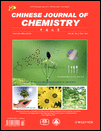Density Functional Theory Study of the Interaction between Thymine and Luteolin
Xiaolan Wang
College of Chemistry and Material Science, Sichuan Normal University, Chengdu, Sichuan 610066, China
Search for more papers by this authorWanfei Cai
College of Chemistry and Material Science, Sichuan Normal University, Chengdu, Sichuan 610066, China
Search for more papers by this authorYan Zheng
College of Chemistry and Material Science, Sichuan Normal University, Chengdu, Sichuan 610066, China
Search for more papers by this authorCorresponding Author
Laicai Li
College of Chemistry and Material Science, Sichuan Normal University, Chengdu, Sichuan 610066, China
College of Chemistry and Material Science, Sichuan Normal University, Chengdu, Sichuan 610066, ChinaSearch for more papers by this authorAnmin Tian
College of Chemistry, Sichuan University, Chengdu, Sichuan 610064, China
Search for more papers by this authorXiaolan Wang
College of Chemistry and Material Science, Sichuan Normal University, Chengdu, Sichuan 610066, China
Search for more papers by this authorWanfei Cai
College of Chemistry and Material Science, Sichuan Normal University, Chengdu, Sichuan 610066, China
Search for more papers by this authorYan Zheng
College of Chemistry and Material Science, Sichuan Normal University, Chengdu, Sichuan 610066, China
Search for more papers by this authorCorresponding Author
Laicai Li
College of Chemistry and Material Science, Sichuan Normal University, Chengdu, Sichuan 610066, China
College of Chemistry and Material Science, Sichuan Normal University, Chengdu, Sichuan 610066, ChinaSearch for more papers by this authorAnmin Tian
College of Chemistry, Sichuan University, Chengdu, Sichuan 610064, China
Search for more papers by this authorAbstract
The density function B3LYP method has been used to optimize the geometries of the luteolin, thymine and luteolin-thymine complexes at 6-31+G∗︁ basis. The vibrational frequencies have been studied at the same level to analyze these seventeen complexes, respectively. Theories of atoms in molecules (AIM) and natural bond orbital (NBO) have been utilized to investigate the hydrogen bonds involved in all the systems. The interaction energies of the complexes corrected by basis set superposition error are between −93.00–−76.69 kJ/mol. The calculating results indicate that strong hydrogen bonding interactions have been found in the luteolin-thymine complexes.
REFERENCES
- 1 López-Lázaro, M.. Mini Rev. Med. Chem., 2009, 9, 31.
- 2 Luczaj, W.; Skrzydlewska, E.. Preventive Med., 2005, 40, 910.
- 3 Liu, J.; Luo, G. A.; Wang, Y. M.; Sun, H. W.. Acta Pharmacol. Sin., 2001, 36, 74 (in Chinese).
- 4 Fernandez, M. T.; Mira, M. L.; Florêncio, M. H.; Jennings, K. R. J.. Inorg. Biochem., 2002, 92, 105.
- 5 Middleton, E. J.; Kandaswami, C.. Biochem. Pharmacol., 1992, 43, 1167.
- 6 Cooks, N. C.; Samman, S.. J. Nutr. Biochem., 1996, 7, 66.
- 7 Panda, S.; Kar, A. J.. Pharm. Pharmacol., 2007, 59, 1543.
- 8 Kazuki, K.; Mari, U.; Hiroaki, Y.; Takashi, H.. Arch. Biochem. Biophys., 2006, 455, 197.
- 9 Hirano, T.; Higa, S.; Arimitsu, J.; Naka, T.; Ogata, A.; Shima, Y.; Fujimoto, M.; Yamadori, T.; Ohkawara, T.; Kuwabara, Y.; Kawai, M.; Matsuda, H.; Yoshikawa, M.; Maezaki, N.; Tanaka, T.; Kawase, I.; Tanaka, T.. Biochem. Biophys. Res. Commun., 2006, 340, 1.
- 10 Ramos, A. A.; Pereira-Wilson, C.; Collins, A. R.. Mutation Research, 2010, 692, 6.
- 11 Niua, S. Y.; Hana, B.; Caoa, W.; Zhang, S. S.. Anal. Chim. Acta, 2009, 651, 42.
- 12 Wang, H. Y.; Zeng, Y. L.; Zheng, S. J.; Meng, L. P.. Acta Phys.-Chim. Sin., 2007, 23, 1131.
- 13
Bader, R. W. F., Atoms in Molecules, A Quantum Theory, Oxford University Press, Oxford, 1990.
10.1093/oso/9780198551683.001.0001 Google Scholar
- 14 Reed, A. E.; Weinhold, F.; Curtiss, L. A.. Chem. Rev., 1988, 88, 899.
- 15 Boys, S. F.; Bernardi, F.. Mol. Phys., 1970, 19, 553.
- 16 Frisch, M. J.; Trucks, G. W.; Schlegel, H. B.; Gill, P. M. W.; Johnson, B. G.; Robb, M. A.; Cheeseman, J. R.; Keith, T.; Petersson, G. A.; Montgomery, J. A.; Raghavachari, K.; AlLaham, M. A.; Zakrzewski, V. G.; Ortiz, J. V.; Foresman, J. B.; Cioslowski, J.; Stefanov, B. B.; Nanayakkara, A.; Challacombe, M.; Peng, C. Y.; Ayala, P. Y.; Chen, W.; Wong, M. W.; Andres, J. L.; Replogle, E. S.; Gomperts, R.; Martin, R. L.; Stewart, J. P.; Head-Gordon, M.; Gonzalez, C.; Pople, J. A., Gaussian 03, Revision A. 7, Gaussian, Inc., Pittsburgh PA, 2003.
- 17 Cox, P. J.; Kumarasamy, Y.; Nahar, L.; Sarker, S. D.; Shoeb, M.. Acta Cryst., 2003, 59, 975.
- 18 Phytochemistry Research Group of Shanghai Institute of Medical Material, Chinese Academy of Sciences (Editing and Translating), The Identification Manual of Flavonoid Compounds, Science Press, Beijing, 1981 (in Chinese).
- 19 Koch, U.; Popelier, P. L. A.. J. Phys. Chem., 1995, 99, 9747.
- 20 Popelier, P. L. A.. J. Phys. Chem. A, 1998, 102, 1873.
- 21 Kowalska, A.; Stobiecka, A.; Wysocki, S.. J. Mol. Struct. (Theochem), 2009, 901, 88.
- 22 Mohajeri, A.; Nobandegani, F. F.. J. Phys. Chem. A, 2008, 112, 281.
- 23 Lv, G.; Chen, Z. X.; Zheng, J.; Wei, F. D.; Jiang, H.; Zhang, R. Y.; Wang, X. M.. J. Mol. Struct. (Theochem), 2009, 939, 44.
- 24 Shi, F. Q.; An, J. Y.; Li, W.. Acta Chim. Sinica, 2004, 63, 283 (in Chinese).
- 25 Fang, G. Y.; Xu, L. N.; Xiao, H. M.. Acta Chim. Sinica, 2005, 63, 1055 (in Chinese).




